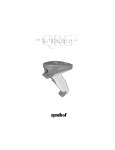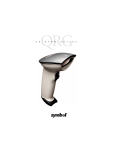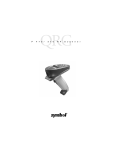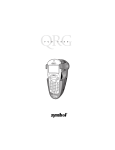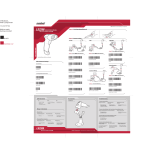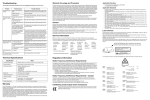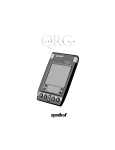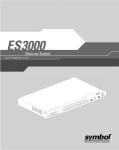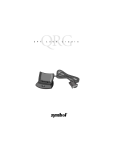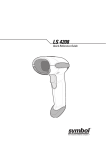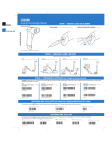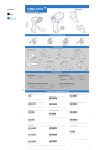Download P 3 0 0 S e r i e s ( S T D / F Z Y / P R O )
Transcript
( P S 3 T 0 D / 0 F S Z e Y r / i P e s R O ) P 3 0 0 S e r i e s ( S T D / F Z Y / P R O ) © 2001 SYMBOL TECHNOLOGIES, INC. All rights reserved. Symbol reserves the right to make changes to any product to improve reliability, function, or design. Symbol does not assume any product liability arising out of, or in connection with, the application or use of any product, circuit, or application described herein. No license is granted, either expressly or by implication, estoppel, or otherwise under any patent right or patent, covering or relating to any combination, system, apparatus, machine, material, method, or process in which Symbol products might be used. An implied license only exists for equipment, circuits, and subsystems contained in Symbol products. Symbol and the Symbol logo are registered trademarks of SymbolTechnologies, Inc. Other product names mentioned in this manual may be trademarks or registered trademarks of their respective companies and are hereby acknowledged. Symbol Technologies, Inc. One Symbol Plaza Holtsville, N.Y. 11742-1300 http://www.symbol.com Patents This product is covered by one or more of the following U.S. and foreign Patents: U.S. Patent No. 4,496,831; 4,593,186; 4,603,262; 4,607,156; 4,652,750; 4,673,805; 4,736,095; 4,758,717; 4,760,248; 4,806,742; 4,816,660; 4,845,350; 4,896,026; 4,897,532; 4,923,281; 4,933,538; 4,992,717; 5,015,833; 5,017,765; 5,021,641; 5,029,183; 5,047,617; 5,103,461; 5,113,445; 5,130,520; 5,140,144; 5,142,550; 5,149,950; 5,157,687; 5,168,148; 5,168,149; 5,180,904; 5,216,232; 5,229,591; 5,230,088; 5,235,167; 5,243,655; 5,247,162; 5,250,791; 5,250,792; 5,260,553; 5,262,627; 5,262,628; 5,266,787; 5,278,398; 5,280,162; 5,280,163; 5,280,164; 5,280,498; 5,304,786; 5,304,788; 5,306,900; 5,321,246; 5,324,924; 5,337,361; 5,367,151; 5,373,148; 5,378,882; 5,396,053; 5,396,055; 5,399,846; 5,408,081; 5,410,139; 5,410,140; 5,412,198; 5,418,812; 5,420,411; 5,436,440; 5,444,231; 5,449,891; 5,449,893; 5,468,949; 5,471,042; 5,478,998; 5,479,000; 5,479,002; 5,479,441; 5,504,322; 5,519,577; 5,528,621; 5,532,469; 5,543,610; 5,545,889; 5,552,592; 5,557,093; 5,578,810; 5,581,070; 5,589,679; 5,589,680; 5,608,202; 5,612,531; 5,619,028; 5,627,359; 5,637,852; 5,664,229; 5,668,803; 5,675,139; 5,693,929; 5,698,835; 5,705,800; 5,714,746; 5,723,851; 5,734,152; 5,734,153; 5,742,043; 5,745,794; 5,754,587; 5,762,516; 5,763,863; 5,767,500; 5,789,728; 5,789,731; 5,808,287; 5,811,785; 5,811,787; 5,815,811; 5,821,519; 5,821,520; 5,823,812; 5,828,050; 5,848,064; 5,850,078; 5,861,615; 5,874,720; 5,875,415; 5,900,617; 5,902,989; 5,907,146; 5,912,450; 5,914,478; 5,917,173; 5,920,059; 5,923,025; 5,929,420; 5,945,658; 5,945,659; 5,946,194; 5,959,285; 6,002,918; 6,021,947; 6,031,830; 6,036,098; 6,047,892; 6,050,491; 6,053,413; 6,056,200; 6,065,678; 6,067,297; 6,068,190; 6,082,621; 6,084,528; 6,088,482; 6,092,725; 6,101,483; 6,102,293; 6,104,620; 6,114,712; 6,115,678; 6,119,944; 6,123,265; 6,131,814; 6,138,180; 6,142,379; 6,172,478; 6,176,428; 6,178,426; 6,186,400; 6,188,681; 6,209,788; 6,216,951; 6,220,514; 6,243,447; 6,244,513; 6,247,647; 6,308,061; 6,250,551; 6,295,031; D305,885; D341,584; D344,501; D359,483; D362,453; D363,700; D363,918; D370,478; D383,124; D391,250; D405,077; D406,581; D414,171; D414,172; D418,500; D419,548; D423,468; D424,035; D430,158; D430,159; D431,562; D436,104. Invention No. 55,358; 62,539; 69,060; 69,187 (Taiwan); No. 1,601,796; 1,907,875; 1,955,269 (Japan); European Patent 367,299; 414,281; 367,300; 367,298; UK 2,072,832; France 81/03938; Italy 1,138,713. rev. 11/01 Q u i c k R e f e r e n c e Parts of the P 300 Series Scanner Scan Window Scan Trigger Tether Hook Laser On LED (red) Decode LED (Green) Cable Interface Port 1 P 3 0 0 S e r i e s ( S T D / F Z Y / P R O ) P 300/302/304 Product Descriptions • • • • P 300STD: undecoded version of the scanner. P 302FZY: decodes damaged or poorly printed bar codes; uses multi-interfaces of RS-232, Wand Emulation, Keyboard Wedge, and Synapse. P 304PRO: scans one and two-dimensional bar codes; uses interfaces of RS-232 and Synapse. P 304IMG: performs point-and-shoot image capture, outputs to digital formats of TIFF, JPEG, and BMP. This version is covered in the P 304IMG Quick Reference Guide, p/n 7240804-xx. 2 Q u i c k R e f e r e n c e Installing the Interface Cable 1. 2. Slide the cable boot downward. Insert the connector into the bottom of the scanner. 3. 4. Slide the cable boot up and line up the Push the boot into the scanner and twist connector tabs with the tabs on the boot clockwise to lock into place. scanner. TAB TAB Note: Different hosts require different interface cables. Refer to the P 300/302/304 Scanner Product Reference Guide (p/n 72-39417-xx) for instructions on connecting interface cables. 3 P 3 0 0 S e r i e s ( S T D / F Z Y / P R O ) Scanning 1. Aim the scanner at the bar code. 2. Press the trigger. The Scan LED lights red, then turns green upon successful decode. A beep indicates success. Scanning Tips • • • Make sure the laser beam covers the entire symbol. For larger symbols, hold the scanner farther away from the symbol. For symbols with bars that are close together, hold the scanner closer to the symbol. Wrong Right Scanning 2-D Bar Codes The P 304PRO scans 1- and 2-dimensional bar codes. To scan a 2-dimensional bar code: 1. Point the scanner at the bar code and press the scan button. Slab Raster 4 Q u i c k R e f e r e n c e 2. As the raster pattern spreads, keep the pattern in the same horizontal plane as the bar code. 3/4” 3/4” 3. The LED turns from red to green and the scanner beeps one or more times to indicate a successful scan. “Tall” PDF Bar Codes If the PDF417 symbol is too “tall” for the vertical scan pattern to cover it, try a slow “up and down” scanning motion. With the raster pattern open, move the scanner slowly down toward the bottom of the symbol, keeping the beam horizontal to the rows, then slowly back up toward the top. The scan beam does not have to be perfectly parallel with the top and bottom of the symbol (up to a 4 o tilt will work). 5 P 3 0 0 S e r i e s ( S T D / F Z Y / P R O ) What Does the Beep Mean? One beep (short high tone) indicates a successful decode. If any other beeps are heard, contact the technical person in charge of scanning. Troubleshooting If the scanner does not work after you’ve followed the operating procedures: • • • • • Check the system power. Check that scanning is enabled. Check for loose cable connections. Check that the scanner is programmed to decode the type of bar code you are scanning. Check that the symbol is not badly defaced. Cleaning Wipe the scanner window periodically with a lens tissue or other material suitable for cleaning optical material. Set Defaults Bar Code Set Defaults Default Table Parameter FZY Default PRO Default Beeper Volume High High Laser On Time 3.0 seconds 5.0 seconds Power Mode Continuous Continuous Beep after Good Decode Enable Enable 6 Q u i c k R e f e r e n c e Parameter FZY Default PRO Default Transmit “No Read” Message Disable Disable Linear Code Type Security Levels 1 1 Bi-directional Redundancy Disable Disable Enable Enable Enable Enable Disable Ignore 7 Enable Enable Enable Enable Disable Ignore 7 Enable Enable System Character System Character Disable Disable 0 Disable Enabled Enable Enable None None Disable Code 128 Parameters Code 128 UCC/EAN Enable Enable Enable Enable Code 39 Parameters Code 39 Trioptic Code 39 Set Length(s) for Code 39 Code 39 Check Digit Verification Transmit Code 39 Check Digit Code 39 Full ASCII Conversion Buffer Code 39 Enable Disable 2 to 55 Disable Disable Disable Disable Enable Disable 1-55 Disable Disable Code 93 Parameters Code 93 Set Length(s) for Code 93 Disable 4-55 Disable 4-55 UPC/EAN Parameters UPC-A UPC-E EAN-8 EAN-13 Bookland EAN Decode UPC/EAN Supplementals Decode UPC/EAN Supplemental Redundancy Transmit UPC-A Check Digit Transmit UPC-E Check Digit UPC-A Preamble UPC-E Preamble Convert UPC-E to A EAN-8 Zero Extend UPC/EAN Security Levels UPC/EAN Coupon Code Convert EAN-8 to EAN-13 7 1 Disable Enabled Disable P 3 0 0 S e r i e s ( S T D / F Z Y / P R O ) Parameter FZY Default PRO Default Interleaved 2 of 5 Parameters I 2 of 5 Set Length(s) for I 2 of 5 I 2 of 5 Check Digit Verification Transmit I 2 of 5 Check Digit Convert I 2 of 5 to EAN 13 Enable 14 Disable Disable Disable Disable 14 Disable Disable Disable Discrete 2 of 5 Parameters Discrete 2 of 5 Set Length(s) for D 2 of 5 Disable 12 Disable 12 Codabar Parameters Codabar Set Length(s) for Codabar CLSI Editing NOTIS Editing Disable 5-55 Disable Disable Disable 5-55 Disable Disable Disable Any Length One Disable Mod10/Mod10 Disable Any Length One Disable Mod10/Mod10 None 0 7013 (<CR/LR> for serial Data as is None 0 Enter Standard 9600 None Do Not Check None None 2 sec. Low 1 8-Bit Disable 0 Standard 9600 None Check None None 2 sec. Low 1 8-Bit Disable 0 MSI Plessey Parameters MSI Plessey Set Length(s) for MSI Plessey MSI Plessey Check Digits Transmit MSI Plessey Check Digit MSI Plessey Check Digit Algorithm Data Option Parameters Transmit Code ID Character Pause Duration Prefix/Suffix Values Scan Data Transmission Format RS-232C Parameters RS-232 Host Type Baud Rate Parity Check Receive Errors Hardware Handshaking Software Handshaking Host Serial Response time-out RTS Line State Stop Bit Select ASCII Format Beep on <BEL> Intercharacter Delay 8 Data as is Q u i c k Parameter R e f e r e n c e FZY Default N/A Wand Parameters Wand Emulator Bar Output Variable Leading Margin Convert all to Code 39 Bar High 80 msec. Disable Keyboard Wedge Parameters Host Type National Keyboard Type Fast Transmit Intercharacter Delay IBM PC/AT North American Enable 0 N/A PDF417 Parameters PDF417 MicroPDF Scanning Mode Raster Height Raster Expansion Aiming Mode N/A Macro PDF Parameters Macro PDF Transmit/Decode Mode N/A Enable Enable Smart Raster 15 11 Slab Raster Buffer all Symbols/ Transmit PDF when complete Disabled Transmit Each Symbol in Codeword Format ESC Characters Delete Character Set ECIs ECI Decoder Transmit Unknown Codewords Transmit Macro PDF UserSelectable Field Transmit File Name Transmit Block Count Transmit Time Stamp Transmit Sender Transmit Addresses Transmit File Size Transmit Checksum Transmit Macro PDF Control Header Last Block Marker PRO Default None Enabled Enabled Disabled N/A Disabled Disabled Disabled Disabled Disabled Disabled Disabled Disabled Disabled 9 P 3 0 0 S e r i e s ( S T D / F Z Y / P R O ) Ergonomic Recommendations Caution: In order to avoid or minimize the potential risk of ergonomic injury follow the recommendations below. Consult with your local Health & Safety Manager to ensure that you are adhering to your company’s safety programs to prevent employee injury. • Reduce or eliminate repetitive motion • Maintain a natural position • Reduce or eliminate excessive force • Keep objects that are used frequently within easy reach • Perform tasks at correct heights • Reduce or eliminate vibration • Reduce or eliminate direct pressure • Provide adjustable workstations • Provide adequate clearance • Provide a suitable working environment • Improve work procedures. Regulatory Information Radio Frequency Interference Requirements This equipment has been tested and found to comply with the limits for a Class B digital device, pursuant to Part 15 of the FCC rules. These limits are designed to provide reasonable protection against harmful interference in a residential installation. This equipment generates, uses, and can radiate radio frequency energy and, if not installed and used in accordance with the instructions, may cause harmful interference to radio communications. However there is no guarantee that interference will not occur in a particular installation. If this equipment does cause harmful interference to radio or television reception, which can be determined by turning the equipment off and on, the user is encouraged to try to correct the interference by one or more of the following measures: • Reorient or relocate the receiving antenna • Increase the separation between the equipment and receiver • Connect the equipment into an outlet on a circuit different from that to which the receiver is connected • Consult the dealer or an experienced radio/TV technician for help. Radio Frequency Interference Requirements - Canada This Class B digital apparatus complies with Canadian ICES-003. Cet appareil numérique de la classe B est conforme à la norme NMB-003 du Canada. CE Marking and European Union Compliance Products intended for sale within the European Union are marked with the CE Mark which indicates compliance to applicable Directives and European Normes (EN), as follows. Amendments to these Directives or ENs are included: Applicable Directives • Electromagnetic Compatibility Directive 89/336/EEC • Low Voltage Directive 73/23/EEC. 10 Q u i c k R e f e r e n c e Applicable Standards • EN 55022:1998, Limits and Methods of Measurement of Radio Disturbance Characteristics of Information Technology Equipment • EN 55024:1998; Information Technology Equipment - Immunity characteristics - Limits and methods of measurement • IEC 1000-4-2:1995; Electromagnetic compatibility (EMC); Part 4:Testing and measurement techniques; Section 4.2:Electrostatic discharge immunity test • IEC 1000-4-3:1997; Electromagnetic Compatibility (EMC); Part 4:Testing and measurement techniques; Section 3. Radiated, radio frequency, electromagnetic field immunity test • IEC 1000-4-4:1995; Electromagnetic compatibility (EMC); Part 4: Testing and measurement techniques; Section 4:Testing electrical fast transient,/Burst immunity • IEC 1000-4-5:1995; Electromagnetic compatibility (EMC), Part 4: Testing and measurement techniques; Section 5: Surge Immunity • IEC 1000-4-6:1996; Electromagnetic compatibility (EMC), Part 4:Testing and measurement techniques; Section 6: Immunity to conducted disturbances, induced by radio frequency fields • IEC 1000-4-11:1994; Electromagnetic compatibility (EMC), Part 4: Testing and measurement techniques; Section 11: Voltage Dips, Short Interruptions, and Voltage Variations • EN 60950 + A1+A2+A3+A4+A11 - Safety of Information Technology Equipment Including Electrical Business Equipment • EN 60825 - Safety of Devices Containing Lasers. Laser Devices Symbol products using lasers comply with US 21CFR1040.10, and IEC825-1:1993, EN608251:1994+A11:1996. The laser classification is marked on one of the labels on the product. Class 1 Laser devices are not considered to be hazardous when used for their intended purpose. The following statement is required to comply with US and international regulations: Caution: Use of controls, adjustments or performance of procedures other than those specified herein may result in hazardous laser light exposure. Class 2 laser scanners use a low power, visible light diode. As with any very bright light source, such as the sun, the user should avoid staring directly into the light beam. Momentary exposure to a Class 2 laser is not known to be harmful. Scanner Labeling 11 P 3 0 0 S e r i e s ( S T D / F Z Y / P R O ) In accordance with Clause 5, IEC 0825 and EN60825, the following information is provided to the user: ENGLISH CLASS 1 CLASS 2 HEBREW CLASS 1 LASER PRODUCT LASER LIGHT DO NOT STARE INTO BEAM CLASS 2 LASER PRODUCT DANISH / DANSK KLASSE 1 KLASSE 1 LASERPRODUKT KLASSE 2 LASERLYF SE IKKE IND I STRÅLEN KLASSE 2 LASERPRODUKT ITALIAN / ITALIANO CLASSE 1 PRODOTTO AL LASER DI CLASSE 1 CLASSE 2 LUCE LASER NON FISSARE IL RAGGIOPRODOTTO AL LASER DI CLASSE 2 DUTCH / NEDERLANDS KLASSE 1 KLASSE-1 LASERPRODUKT KLASSE 2 LASERLICHT NIET IN STRAAL STAREN KLASSE-2 LASERPRODUKT NORWEGIAN / NORSK KLASSE 1 LASERPRODUKT, KLASSE 1 KLASSE 2 LASERLYS IKKE STIRR INN I LYSSTRÅLEN LASERPRODUKT, KLASSE 2 FINNISH / SUOMI LUOKKA 1 LUOKKA 1 LASERTUOTE LUOKKA 2 LASERVALO ÄLÄ TUIJOTA SÄDETTÄ LUOKKA 2 LASERTUOTE PORTUGUESE / PORTUGU ÊS CLASSE 1 PRODUTO LASER DA CLASSE 1 CLASSE 2 LUZ DE LASER NÃO FIXAR O RAIO LUMINOSO PRODUTO LASER DA CLASSE 2 FRENCH / FRANÇAIS CLASSE 1 PRODUIT LASER DE CLASSE 1 CLASSE 2 LUMIERE LASER NE PAS REGARDER LE RAYON FIXEMENT PRODUIT LASER DE CLASSE 2 SPANISH / ESPAÑOL CLASE 1 PRODUCTO LASER DE LA CLASE 1 CLASE 2 LUZ LASER NO MIRE FIJAMENTE EL HAZ PRODUCTO LASER DE LA CLASE 2 GERMAN / DEUTCH KLASSE 1 LASERPRODUKT DER KLASSE 1 KLASSE 2 LASERSTRAHLEN NICHT DIREKT IN DEN LASERSTRAHL SCHAUEN LASERPRODUKT DER KLASSE 2 SWEDISH / SVENSKA KLASS 1 LASERPRODUKT KLASS 1 KLASS 2 LASERLJUS STIRRA INTE MOT STRÅLEN LASERPRODUKT KLASS 2 12 Q u i c k R e f e r e n c e Warranty Symbol Technologies, Inc. (“Symbol”) manufactures its hardware products in accordance with industry-standard practices. Symbol warrants that for a period of twelve (12) months from date of shipment, products will be free from defects in materials and workmanship. This warranty is provided to the original owner only and is not transferable to any third party. It shall not apply to any product (i) which has been repaired or altered unless done or approved by Symbol, (ii) which has not been maintained in accordance with any operating or handling instructions supplied by Symbol, (iii) which has been subjected to unusual physical or electrical stress, misuse, abuse, power shortage, negligence or accident or (iv) which has been used other than in accordance with the product operating and handling instructions. Preventive maintenance is the responsibility of customer and is not covered under this warranty. Wear items and accessories having a Symbol serial number will carry a 90-day limited warranty. Non-serialized items will carry a 30-day limited warranty. Warranty Coverage and Procedure During the warranty period, Symbol will repair or replace defective products returned to Symbol’s manufacturing plant in the US. For warranty service in North America, call the Symbol Support Center at 1-800-653-5350. International customers should contact the local Symbol office or support center. If warranty service is required, Symbol will issue a Return Material Authorization Number. Products must be shipped in the original or comparable packaging, shipping and insurance charges prepaid. Symbol will ship the repaired or replacement product freight and insurance prepaid in North America. Shipments from the US or other locations will be made F.O.B. Symbol’s manufacturing plant. Symbol will use new or refurbished parts at its discretion and will own all parts removed from repaired products. Customer will pay for the replacement product in case it does not return the replaced product to Symbol within 3 days of receipt of the replacement product. The process for return and customer’s charges will be in accordance with Symbol’s Exchange Policy in effect at the time of the exchange. Customer accepts full responsibility for its software and data including the appropriate backup thereof. Repair or replacement of a product during warranty will not extend the original warranty term. Symbol’s Customer Service organization offers an array of service plans, such as on-site, depot, or phone support, that can be implemented to meet customer’s special operational requirements and are available at a substantial discount during warranty period. General Except for the warranties stated above, Symbol disclaims all warranties, express or implied, on products furnished hereunder, including without limitation implied warranties of merchantability and fitness for a particular purpose. The stated express warranties are in lieu of all obligations or liabilities on part of Symbol for damages, including without limitation, special, indirect, or consequential damages arising out of or in connection with the use or performance of the product. Seller’s liability for damages to buyer or others resulting from the use of any product, shall in no way exceed the purchase price of said product, except in instances of injury to persons or property. Some states (or jurisdictions) do not allow the exclusion or limitation of incidental or consequential damages, so the preceding exclusion or limitation may not apply to you. 13 Service Information Before you use the unit, it must be configured to operate in your facility’s network and run your applications. If you have a problem running your unit or using your equipment, contact your facility’s Technical or Systems Support. If there is a problem with the equipment, they will contact the Symbol Support Center: United States1 1-800-653-5350 1-631-738-2400 Canada 905-629-7226 United Kingdom 0800 328 2424 Asia/Pacific 337-6588 Australia 1-800-672-906 Austria/Österreich 1-505-5794 Denmark/Danmark 7020-1718 Finland/Suomi 9 5407 580 France 01-40-96-52-21 Germany/Deutchland 6074-49020 Italy/Italia 2-484441 Mexico/México 5-520-1835 Netherlands/Nederland 315-271700 Norway/Norge 66810600 South Africa 11-4405668 Spain/España +913244000 Sweden/Sverige 84452900 Latin America Sales Support 1-800-347-0178 Inside US +1-561-483-1275 Outside US Europe/Mid-East Distributor Operations Contact local distributor or call +44 208 945 7360 1 Customer support is available 24 hours a day, 7 days a week. For the latest version of this guide go to:http://www.symbol.com/manuals. 72-39416-01 Revision C — November 2001 Symbol Technologies, Inc. One Symbol Plaza Holtsville, NY 11742-1300
















